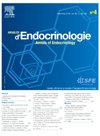有机污染物混合物对甲状腺轴的影响
IF 2.9
3区 医学
Q3 ENDOCRINOLOGY & METABOLISM
引用次数: 0
摘要
内分泌干扰物(EDs)因其对人类和环境健康的不利影响而得到广泛认可。研究表明,它们无处不在的存在影响了两栖动物的新陈代谢,导致了它们几十年来的衰落。材料与方法在热带爪蟾发育的3个阶段(NF 47、62和65)研究了6种致肥性EDs (TBT、TCS、DDE、PBDE、BaP和DEHP)在符合环境质量标准(EQS)条件下的混合物。特别关注甲状腺系统,它在代谢调节中起着关键作用。结果与讨论结果表明,短期暴露可诱导暴露的蝌蚪大脑细胞增殖增加,细胞死亡率降低。此外,在活动阶段,在黑暗中观察到流动性显著增加。在分子水平上,暴露于混合物会导致特定基因表达的改变。长期来看,甲状腺的组织学分析显示结构改变,其特征是胶体含量减少,甲状腺细胞聚集,滤泡紊乱。结论这些发现表明,这种致肥混合物在测试的EQS浓度下并不是惰性的,强调了研究化学混合物而不是单个化合物的重要性。本文章由计算机程序翻译,如有差异,请以英文原文为准。
Impact of a mixture of organic pollutants on the thyroid axis
Introduction
Endocrine disruptors (EDs) are widely recognized for their adverse effects on human and environmental health. Studies suggest that their ubiquitous presence impacts amphibian metabolism, contributing to their decline over several decades.
Materials and methods
A mixture of six obesogenic EDs (TBT, TCS, DDE, PBDE, BaP, and DEHP) was studied at concentrations corresponding to environmental quality standards (EQS) over short- and long-term exposure periods in Xenopus tropicalis at three developmental stages (NF 47, 62, and 65). Particular attention was given to the thyroid system, which plays a key role in metabolic regulation.
Results and discussion
The results show that short-term exposure induces increased proliferation and reduced cell mortality in the brains of exposed tadpoles. Additionally, a significant increase in mobility was observed in darkness during the active phase. At the molecular level, exposure to the mixture led to alterations in the expression of specific genes.
In the long term, histological analysis of the thyroid glands revealed structural changes, characterized by a reduction in colloid content, clusters of thyrocytes, and follicular disorganization.
Conclusion
These findings indicate that this obesogenic mixture is not inert at the tested EQS concentrations in exposed frogs, highlighting the importance of studying chemical mixtures rather than individual compounds.
求助全文
通过发布文献求助,成功后即可免费获取论文全文。
去求助
来源期刊

Annales d'endocrinologie
医学-内分泌学与代谢
CiteScore
4.40
自引率
6.50%
发文量
311
审稿时长
50 days
期刊介绍:
The Annales d''Endocrinologie, mouthpiece of the French Society of Endocrinology (SFE), publishes reviews, articles and case reports coming from clinical, therapeutic and fundamental research in endocrinology and metabolic diseases. Every year, it carries a position paper by a work-group of French-language endocrinologists, on an endocrine pathology chosen by the Society''s Scientific Committee. The journal is also the organ of the Society''s annual Congress, publishing a summary of the symposia, presentations and posters. "Les Must de l''Endocrinologie" is a special booklet brought out for the Congress, with summary articles that are always very well received. And finally, we publish the high-level instructional courses delivered during the Henri-Pierre Klotz International Endocrinology Days. The Annales is a window on the world, keeping alert clinicians up to date on what is going on in diagnosis and treatment in all the areas of our specialty.
 求助内容:
求助内容: 应助结果提醒方式:
应助结果提醒方式:


